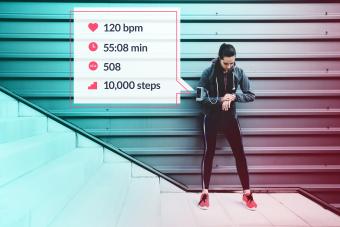
Charting exercise progress provides numerous benefits. You'll have visual proof of how far your workout routine has come; that, in turn, may motivate you to continue your efforts or even to ramp them up.
Sample Exercise Progress Log
Weight loss isn't the best indicator of increased fitness. In fact, trusting the scale to reveal your progress can misleading. While you're building muscle and burning fat, the scale may not move down at all in the beginning, and that can be frustrating and discouraging. Instead, measure your progress as your capabilities, strength, and stamina increase. The sample log below helps you chart your progress from month to month as your body changes. If you need help downloading or printing this log for your own use, check out a guide for Adobe printables.

Progress Charting Options
Each person has different needs when it comes to exercise. Losing weight is an aim for many people, but others chart their progress in terms of weightlifting success. Keeping track of how you're doing can only help you, and charting this information shows you progress you may not otherwise notice.
Weight Loss
For people whose workout goals include shedding pounds, charting your progress from week to week helps you see if you're meeting your weight loss goals. Some people weigh themselves daily; others only face the scale once per week. Make sure you weigh yourself at the same time and preferably with no clothing on for the most accurate measurements. If your only goal is to lose weight, making nutritional changes will yield faster results than exercise alone.
Inches Lost
Along with dropped pounds, your body will drop inches as excess fat melts away. The scale is not always a good indicator of progress because muscle tissue takes up less space. You might see more of a change in the measurements around your waist, hips, thighs, upper arms and chest.
Number of Sets
Want to grow stronger and increase your muscle mass? Recording your increasing number of sets shows how much more weight you're able to lift as you progress in your efforts. Newbies to weightlifting may begin with a small number of sets and reps; they can watch these numbers go up as their fitness levels increase.

Stamina
Many people who are new to exercising find that they're unable to work out for long periods of time. After training for a while, however, their stamina improves. Charting progress in this area may show significant gains in the time spent exercising.
Specific Goal
Suppose you can do 20 pushups, but you want to work your way up to 100 pushups. Track your progress with each session, challenging yourself to increase the number in increments of five or 10. This also works for exercises like pull-ups, jumping jacks, situps and more.
Making Progress
As long as you work hard, you should see some progress in your fitness level, regardless of your specific aims. Charting your progress is also useful if you notice no significant improvements over a period of time. If you see a plateau, you may need to shake things up in the exercise department, either by introducing a new routine, eating less, eating more, using different equipment or taking a new class at your gym. Little improvements all add up to a big level of fitness, which should be everyone's ultimate goal.







